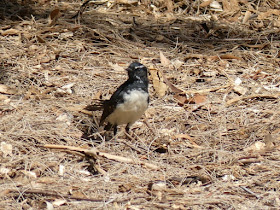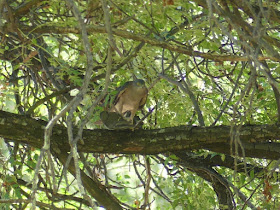On a recent family-related visit to the inland city of Wagga Wagga I spent some time in the very pleasant native plants section of their impressive botanic gardens, set on the lower slopes of forested Willans Hill. I knew then that I needed to share the discovery with you, as part of my sporadic series on Australian native plant-oriented botanic gardens, especially regional ones. (You can find more under the 'botanic gardens' Label to the right of this panel.)
 |
| A general panoramic view of part of the gardens. |
Wagga Wagga (you'll get into trouble with locals if you try saying just one Wagga!) is New South Wales' largest inland city, with well over 50,000 people, set on the Murrumbidgee River in the remnant woodlands of the dry south-west slopes region. It is prosperous and always busy, so the gardens are something of a haven, as gardens are.
 |
| You can find Wagga Wagga at the end of the red arrow above. |
Their story began in the 1950s, when the City Council and the New South Wales Soil Conservation Service began remediating on old gravel quarry by contouring the site and planting thousands of trees, mostly native. Early in the following decade a plan for a botanic gardens was prepared, with the first plantings in 1962; it opened in 1969. The native gardens, along with a big rose garden, were part of the original plans, perhaps unusual for the time. Other specialty gardens feature camelias, cacti, proteas, water saving techniques and a Shakespearian garden, as well as a little zoo and a miniature railway, but I'll leave you to discover those for yourself. The overall area is some 20 hectares, of which I estimate that some 3-4 hectares comprise the native section, at the northern end of the complex.
 |
| The entrance to the native plants section. As you can see from the previous photo the section comprises a mix of garden beds and lawns, with many mature trees, mostly eucalypts. |
The plantings are quite eclectic, being drawn from widely across the continent, and labelling is minimal, which can lead to some frustration if you have a mind like mine which likes to put names onto things. Accordingly I can't name all the photos which follow, and any assistance from you would be greatly appreciated. It is particularly difficult with the eucalypts - Australia has nearly 900 of them, so without knowledge of their place of origin, an amateur such as I hasn't much of a hope.
Here are a few of the trees, starting with some that I do recognise (not many eucalypts in this category!), progressing to a couple that I might know, and ending with one about which I have no idea! A plant is none the less beautiful for lack of a name of course.
 |
| Hoop Pine Araucaria cunninghamii, a rainforest tree from the east coast of Australia, from the Macleay River to Cape York and into New Guinea. More about its family here. |
 |
| Firewheel Tree Stenocarpus sinuatus, another east coast rainforest tree, this one in the Proteaceae family. |
And a very attractive eucalypt about which I have no clue at all - any suggestions welcomed!
The garden beds are generally well-tended, though one has some large clumps of what is presumably intended to be Swamp Foxtail Cenchrus purpurascens (also known as Pennisetum alopecuroides). I have some concerns with this for a couple of reasons. One is that there is uncertainty about whether it really is a native grass, and other members of the genus (from Africa, Asia and South America) are highly invasive weeds. Moreover one authority I've consulted is pretty sure that this is another Cenchrus, which means that is an invasive weed; KayePea suggests C. setaceus. I think that prudence would mean removing this planting. (My thanks to KayePea, below, and my friend and weed expert Geoff Butler for assisting with this issue.)
 |
| If my authority is right about these they could well take over this bed (and beyond). |
Most beds are weed-free however.
 |
| A massed planting of a pigface, probably Carpobrotus sp. |
 |
| Fern-leafed Grevillea G. pteridifolia, a magnificent sight in flower, found across northern Australia. |
 |
| A guinea flower, Hibbertia sp, family Dillenaceae; the genus has some 150 species from across the country. |
And of course there were birds present, as there weren't many people around when I was there. Unsurprisingly many of these were familiar and common urban species.
 |
| Young Willie Wagtail Rhipidura leucophrys, surely one of Australia's favourite birds, bold and curious and found across the entire continent. |
 |
| Male Australian Magpie Gymnorhina tibicen, another ubiquitous species. |
 |
| Yellow-rumped Thornbill Acanthiza chrysorrhoa, another widespread species, though small and often overlooked despite feeding on the ground in flocks. |
Others were a little less common, especially in suburbia.
 |
| Immature Fan-tailed Cuckoo Cacomantis flabelliformis; this bird, though relatively large, was probably raised by either the thornbills or Superb Fairywrens which also live in the gardens. |
 |
| Double-barred Finch Taeniopygia bichenovii, a little delight which certainly seems to be declining around Canberra at least. |
I was surprised at the number of exotic Common Blackbirds Turdus merula present (though the combination of open space and understorey suits them well); however while I was there their numbers decreased by one! Nothing to do with me, but this deadly Brown Goshawk Accipiter fasciatus, flew over me as I sat on a bench with lunch still struggling in its claws, then perched in cover for a while before taking its meal elsewhere.
I can't promise that sort of drama on each visit, but you won't know until you try! I'm sure you won't regret an hour or so spent there however.
And I've just discovered there's a rainforest gully tucked away there too (in Wagga Wagga?!). Oh well, I'll just have to go back again I guess. Maybe I'll see you there.
NEXT POSTING THURSDAY 31 MAY
(And
remember that you can get a reminder when the next post appears by
putting your email address in the Follow by Email box in the top right
of this screen.
And I'd love to receive your comments - it's easy and you don't need to sign in!)
And I'd love to receive your comments - it's easy and you don't need to sign in!)








When I was fit enough to orienteer I'd occasionally attend championships and noted that members of the Waggaroos always yelled "Wagga Wagga" as they crossed the finish line.
ReplyDeleteWe have visited the Gardens and have positive memories of them. Which, as it was about 38C on the day we swung by, means they must be at least excellent at a more sensible temperature.
Whenever I look at eucalypts these days I just sigh and think to myself how crap I am at identifying them now.
ReplyDeleteI'm not sure that big grass is one of the pampases, btw. The leaves don't look quite right -- a bit soft and narrow, but difficult to say from the photo.
Thank you both for commenting. I can usually rely on you two, even with an apparently declining readership otherwise! You must go back there some time Martin - you'd enjoy it even more when not 38! Excellent cultural observation there too.
ReplyDeleteI'd like to be wrong about the grasses Susan; I've just thought of someone I can ask too. As for eucs - they're OK in an area we're familiar with, but beyond that...
I agree with Susan about the grasses and think they may be more like Fountain Grass, Cenchrus setaceous - just like a junior pampas and just as bad, weed-wise! Another South African import - ugh. Great post thanks Ian.
ReplyDeleteThanks KayePea, that's a big help and I'll follow up that line.
ReplyDeleteSusan and KayePea, please see my amended text above with regard to the grass.
ReplyDelete